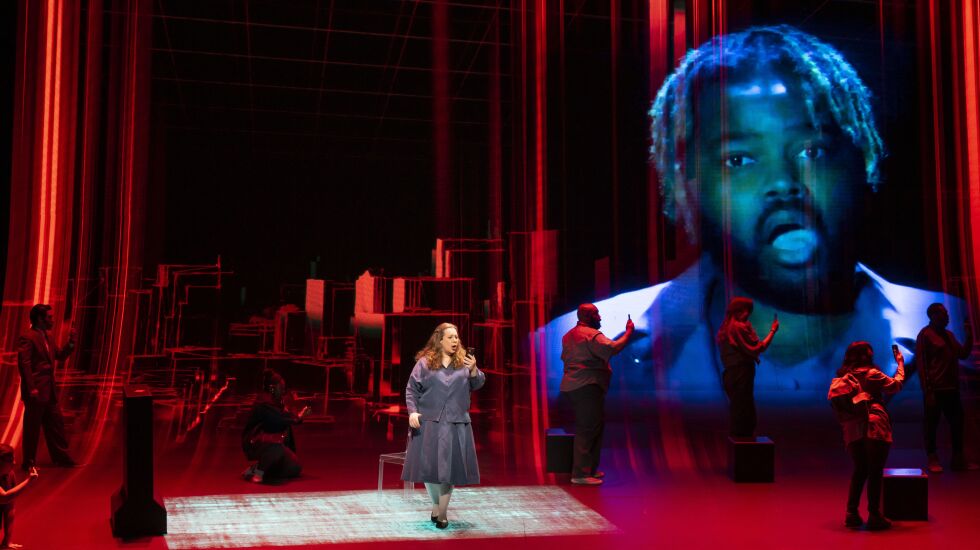
Audacious, topical and thrillingly contemporary in look, sound and structure. Lyric Opera of Chicago’s world premiere of “Proximity” Friday evening at the Lyric Opera House is all that and more.
Unlike festivals and specialty houses, conventional opera companies traditionally have offered an occasional premiere as a kind of a prestige project, and these presentations usually prove to be tough sells at the box office.
But as companies rapidly strive to become more diverse and inclusive, and audience tastes shift in favor of the contemporary, companies are recalibrating toward the new, and Lyric is striving to be at the forefront of this change.
It is certainly possible to quibble with aspects of “Proximity,” but Lyric deserves enormous credit for embracing this undertaking and going all in both in terms of scale and daring. It is, by any measure, a major event.
“Proximity,” which runs a little more than 2¼ hours with one intermission, consists of a trilogy of amplified, contemporary-themed operas by very different yet all highly acclaimed composers, including two winners of the Pulitzer Prize for Music.
That alone already makes it unusual and likely unprecedented, but what really sets this offering apart is that the three operas have been “shuffled,” to use the terminology of stage director Yuval Sharon. That means the scenes of the two longer operas have been intermingled and wrapped around the shortest of the three.

And, indeed, the biggest question of the evening was: Does this radical approach work? The argument for it is obvious and compelling. With the internet and social media, information is delivered in just this kind of splintered, intersecting way, and it can be said that this structure ties together the three pieces in a way that wouldn’t have been possible otherwise.
But the stronger counter-argument, I believe, is that they would have been better served by being performed as three discrete works with a break between them. The constant shifts in the current structure never allow the emotional and musical arcs of the two larger works to be fully realized or appreciated.
This is especially true for composer Caroline Shaw’s “Four Portraits,” which deals with the disconnecting, numbing effects of technology on a couple. Lost via the shuffling is some of the subtlety and build-up of this beautifully integrated work, with its penetrating, alluring harmonies and words that blur into vocalizations in intoxicating and sometimes disorienting ways.

(A particular highlight is an electronically manipulated singing GPS phone voice provided by mezzo-soprano Corinne Wallace-Crane, which generates abundant and well-deserved laughs.)
The shuffling also means that John Luther Adams’ “Night,” which runs a little more than 10 minutes, comes off as a bit of an afterthought at the end of the first half. Not really an opera so much as what he calls a “dramatic conception,” a reflective setting of a poem about climate change by John Haines, it needs its own space on the program to be fully appreciated.
“The Walkers” draws the most attention, because it is the longest of the three operas and deals with the hot-button subjects of gang warfare and gun violence in Chicago. Haitian-American composer Daniel Bernard Roumain has created a rich, captivating and sometimes cinematic score tinged variously with elements of jazz, blues and especially rap.
Anna Deavere Smith, a famed actress, author and playwright, provides the libretto, and she arguably tries to do too much. In some ways, this opera is an extension of her “verbatim theater” in which she bases the text on real-life interviews, but here this documentary approach is intermingled with fictional, composite characters. The result is an uneasy mix of fiction and non-fiction that comes off a bit forced and lacking a solid emotional core.
But that is not to say there are not moving moments, especially in the final scene when a mother, Yasmine Miller, portrayed with moving conviction and authenticity by soprano Whitney Morrison, sings of her 20-month-old baby killed by a stray bullet.
Also deserving note is soprano Kearstin Piper Brown, who brings the right doses of braggadocio and vulnerability to the Chief’s Daughter No. 1, a gang leader.
Sharon, who is also credited as the co-curator of “Proximity,” along with soprano Renée Fleming, Lyric’s special projects adviser, has earned an international reputation for innovative direction, and he brings no shortage of inventiveness, thoughtfulness and vibrancy to every scene.
The entire opera takes place on a stage-wide LED screen that curves from the back wall onto the floor and displays an ever-changing, extraordinary kaleidoscope of imagery, from forest scenes to abstracted swirls and cascades of color. At times, singers appear to walk on, over and through the streets of Chicago, and at other times, they are almost subsumed by the visuals in ways that can be both breathtaking and dizzying.
There are other striking sights, like a Jeep that is driven onstage in “The Walkers” and the Sibyl in “The Night,” who is suspended in front of a vast celestial panorama.
Praise also goes to conductor Kazem Abdullah, who is making his Lyric debut. Leading a pit orchestra augmented to nearly 70 musicians, he adroitly handles the divergent, constantly shifting musical styles of the three operas.




!["[T]he First and Fifth Amendments Require ICE to Provide Information About the Whereabouts of a Detained Person"](https://images.inkl.com/s3/publisher/cover/212/reason-cover.png?w=600)


